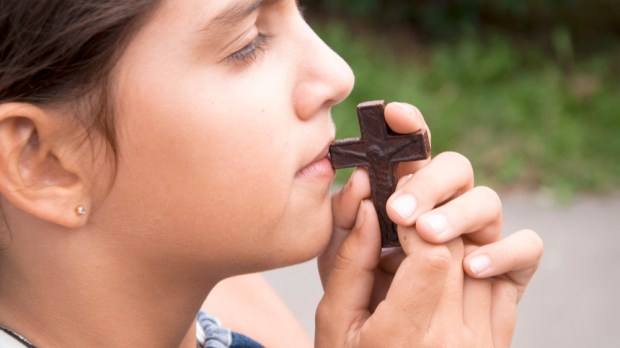The COVID-19 outbreak has made it difficult for many people to leave their homes. As a result, there is a rise in digital fitness apps and videos promoting physical activity — from Zumba to Pilates to H.I.T workouts, all streamed via personal electronic devices. Some people like to pray when they exercise — push-ups for the length of a Hail Mary and “Jesus, remember me when you come into your Kingdom” for long runs, for example. But few actually use physical movement as prayer. Catholicism, both in the east and the west, has a rich tradition of praying with the body … the Sign of the Cross, kneeling, prostrating, touching the ground, and bowing are a few examples of physical movements that are intended primarily for connecting with the Divine.
When working with children and adolescents who suffer from depression or anxiety, I often ask them to engage in some physical activity that turns them away from certain unhealthy behavior, even just for a moment. Thinking about thoughts and feelings and how to change them, though helpful, only goes so far. After all, a key yet often neglected element in Cognitive Behavioral Therapy (CBT), a widely-used approach to psychotherapy, is “behavioral activation.” Doing what we find enjoyable, or at least meaningful, even when we don’t want to do it, can help reduce automatic negative thoughts and improve mood. A small movement that slightly disrupts a rigid pattern is a big victory.
As with psychotherapy, spirituality can unfortunately become primarily an activity of the mind. It’s not uncommon to forget to bring the body along when engaging in spiritual exercises. If prayer involves the whole person coming before God, then the body prays as well. The human person nevertheless is both body and soul.
Prayerful physical movement can shift our sense of reality in ways that the mind alone cannot. Young children, for example, might not understand what it means to have faith in Jesus in times like these, but when they imitate their parents bowing their heads at the name of Jesus or kissing the crucifix of a rosary or signing themselves with the Sign of the Cross when they hear a siren, there’s a slight change to the lens through which they look at the same reality.
Body movements can help direct the movement of the soul, for both the mover and observer. They disrupt patterns of retreating into the mind and getting stuck in the web of worries that are out of our control. Whether the Pilgrim Church as the Body of Christ is suffering or rejoicing, feels motivated or unmotivated, we continue to move toward the Father. Often the mind and heart struggle to comprehend and accept our current reality, but meaningful movements like a tugboat pull us along. The paradox is that such movements lead to stability of the restless heart, which then reorients itself to move again toward its final destination.
Here are 9 ways of praying with the body, adapted from the methods attributed to St. Dominic, that you and your children as a family could incorporate into your daily routine during this time of limited mobility.
1. Bow deeply before a crucifix/cross or a home shrine, making the Sign of the Cross upon passing it.
2. Prostrate(lie face down)before the crucifix, praying “Lord, have mercy; Christ, have mercy” when dropping to the floor. Remain there in silence for a minute or two.
3. Beat the heart. With the right fist, touch the heart saying: “Through my fault, through my fault, through my most grievous fault.” (Or recite the entire Confiteor.)
4. Kneelfor a few seconds and stand for a few seconds with eyes fixed on the crucifix. Repeat five to 10 times (or more).
5. Join hands togetherwith your head slightly bowed recognizing God’s presence. Then open both arms out in a V-shape welcoming God’s Spirit. Then put forward both hands with palms facing up to receive His gifts. Each movement should last for a few seconds.
6. Stretch out both arms in the form of a cross with palms wide open, asking the Lord for what you desire for yourself and others.
7. Stretch out both arms toward the crucifix or heavenas if reaching for it or wanting to be lifted up.
8. Kiss the Bible or Book of the Gospels or touch it to your forehead before reading a passage from it.
9. Turn a walkinto a pilgrimageto a sacred image in other parts of the house or in your yard or garden. Venerate (e.g., touch with hands or to forehead, kiss, etc.) the images and make the Sign of the Cross.

Read more:
5 Ways to make peace with the body God gave you

Read more:
How treating your body with respect benefits your soul

